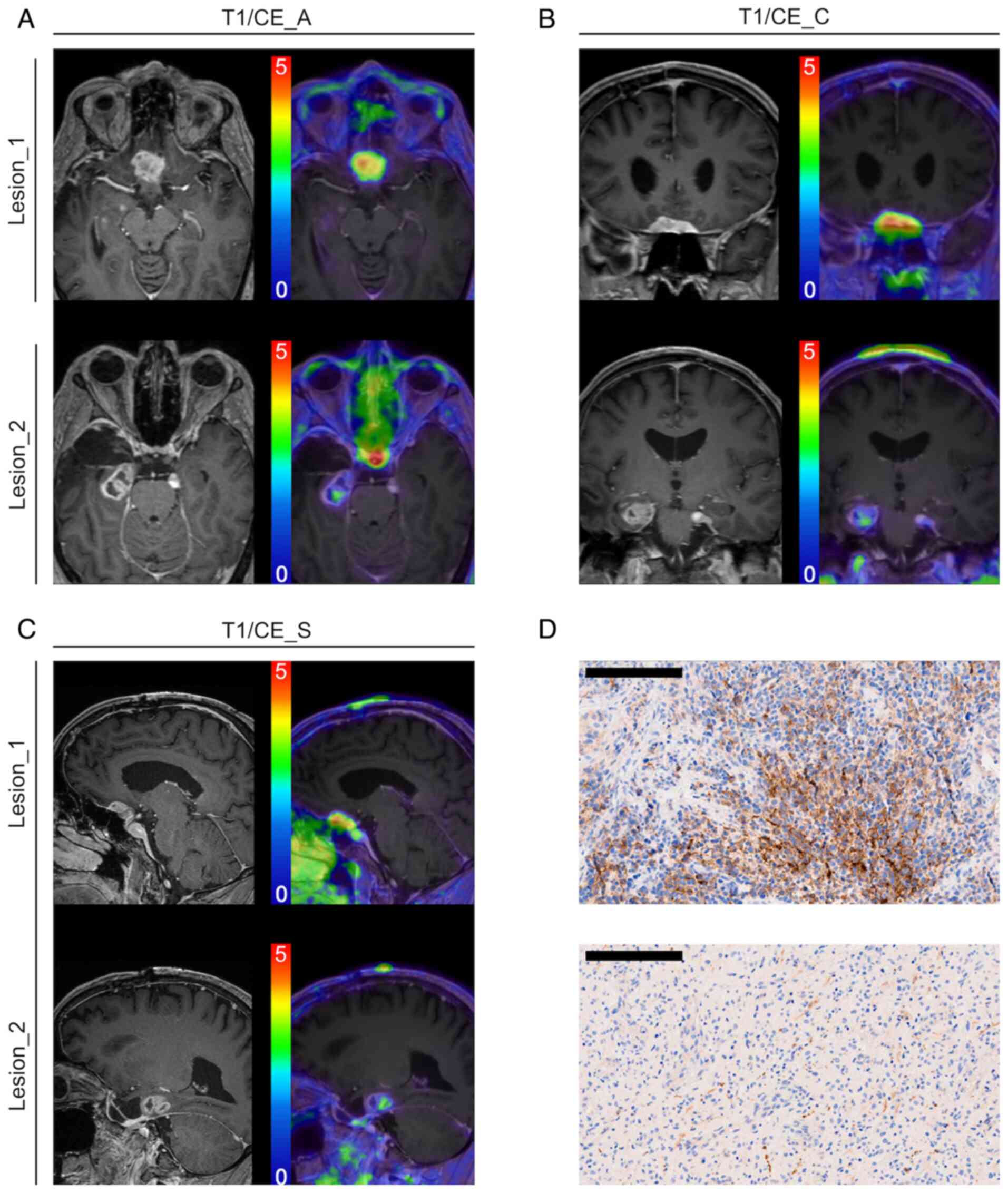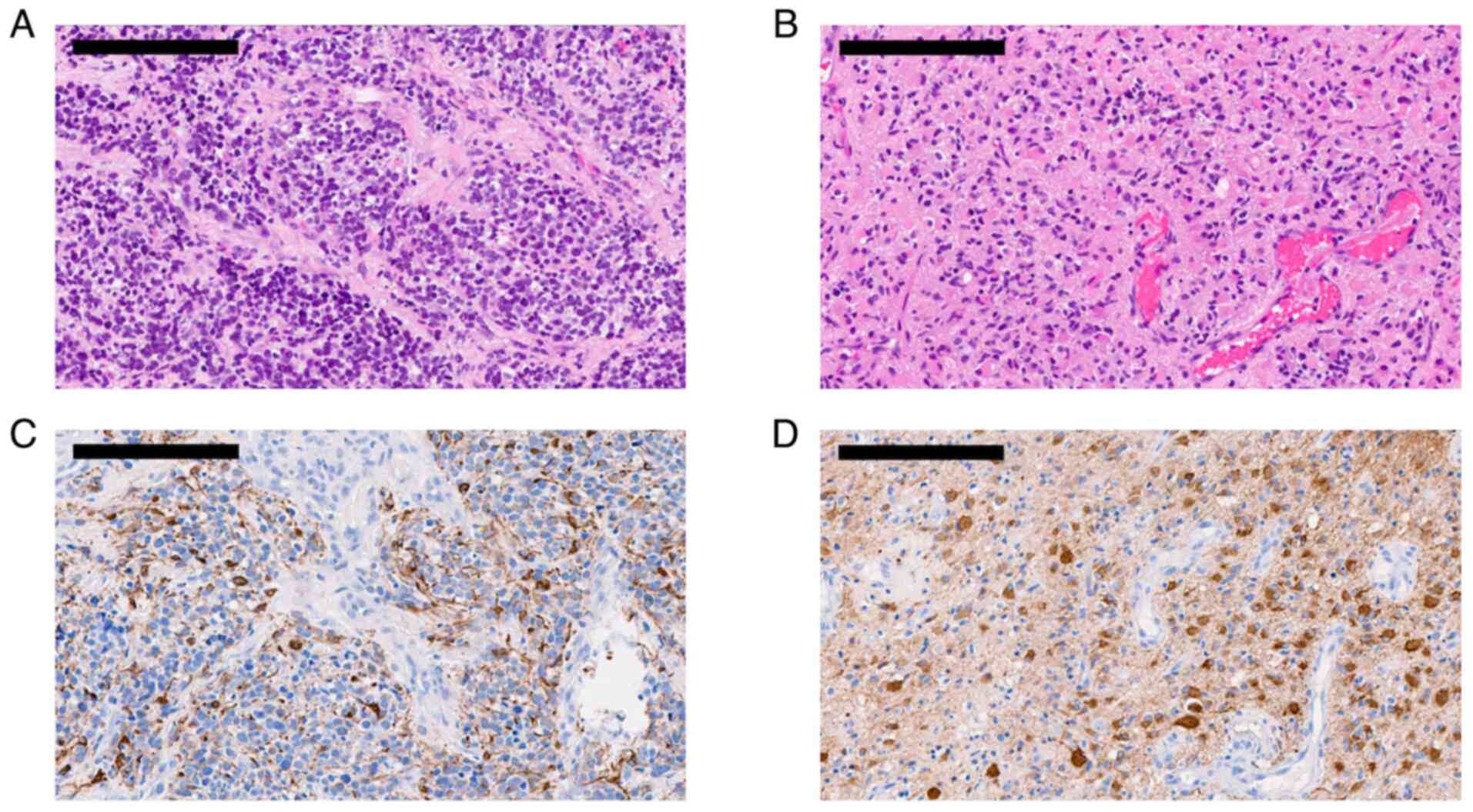|
1
|
Ostrom QT, Price M, Neff C, Cioffi G,
Waite KA, Kruchko C and Barnholtz-Sloan JS: CBTRUS statistical
report: primary brain and other central nervous system tumors
diagnosed in the United States in 2016–2020. Neuro Oncol. 25 (12
Suppl 2):iv1–iv99. 2023. View Article : Google Scholar : PubMed/NCBI
|
|
2
|
Wiemels J, Wrensch M and Claus EB:
Epidemiology and etiology of meningioma. J Neurooncol. 99:307–314.
2010. View Article : Google Scholar : PubMed/NCBI
|
|
3
|
Sales AHA, Beck J, Schnell O, Fung C,
Meyer B and Gempt J: Surgical treatment of glioblastoma:
State-of-the-art and future trends. J Clin Med. 11:53542022.
View Article : Google Scholar : PubMed/NCBI
|
|
4
|
Chen WC, Lucas CG, Magill ST, Rogers CL
and Raleigh DR: Radiotherapy and radiosurgery for meningiomas.
Neurooncol Adv. 5 (Suppl 1):i67–i83. 2023.PubMed/NCBI
|
|
5
|
Tirosh A and Kebebew E: The utility of
(68)Ga-DOTATATE positron-emission tomography/computed tomography in
the diagnosis, management, follow-up and prognosis of
neuroendocrine tumors. Future Oncol. 14:111–122. 2018. View Article : Google Scholar : PubMed/NCBI
|
|
6
|
Wu W, Zhou Y, Wang Y, Liu L, Lou J, Deng
Y, Zhao P and Shao A: Clinical significance of somatostatin
receptor (SSTR) 2 in meningioma. Front Oncol. 10:16332020.
View Article : Google Scholar : PubMed/NCBI
|
|
7
|
Rachinger W, Stoecklein VM, Terpolilli NA,
Haug AR, Ertl L, Pöschl J, Schüller U, Schichor C, Thon N and Tonn
JC: Increased 68Ga-DOTATATE uptake in PET imaging discriminates
meningioma and tumor-free tissue. J Nucl Med. 56:347–353. 2015.
View Article : Google Scholar : PubMed/NCBI
|
|
8
|
Kiviniemi A, Gardberg M, Frantzen J,
Pesola M, Vuorinen V, Parkkola R, Tolvanen T, Suilamo S, Johansson
J, Luoto P, et al: Somatostatin receptor subtype 2 in high-grade
gliomas: PET/CT with (68)Ga-DOTA-peptides, correlation to
prognostic markers, and implications for targeted radiotherapy.
EJNMMI Res. 5:252015. View Article : Google Scholar : PubMed/NCBI
|
|
9
|
Rison RA, Kidd MR and Koch CA: The CARE
(CAse REport) guidelines and the standardization of case reports. J
Med Case Rep. 7:2612013. View Article : Google Scholar : PubMed/NCBI
|
|
10
|
Wesseling P and Capper D: WHO 2016
Classification of gliomas. Neuropathol Appl Neurobiol. 44:139–150.
2018. View Article : Google Scholar : PubMed/NCBI
|
|
11
|
Stupp R, Mason WP, van den Bent MJ, Weller
M, Fisher B, Taphoorn MJ, Belanger K, Brandes AA, Marosi C, Bogdahn
U, et al: Radiotherapy plus concomitant and adjuvant temozolomide
for glioblastoma. N Engl J Med. 352:987–996. 2005. View Article : Google Scholar : PubMed/NCBI
|
|
12
|
Page MJ, McKenzie JE, Bossuyt PM, Boutron
I, Hoffmann TC, Mulrow CD, Shamseer L, Tetzlaff JM, Akl EA, Brennan
SE, et al: The PRISMA 2020 statement: An updated guideline for
reporting systematic reviews. BMJ. 372:n712021. View Article : Google Scholar : PubMed/NCBI
|
|
13
|
Collamati F, Pepe A, Bellini F, Bocci V,
Chiodi G, Cremonesi M, De Lucia E, Ferrari ME, Frallicciardi PM,
Grana CM, et al: Toward radioguided surgery with β-decays: Uptake
of a somatostatin analogue, DOTATOC, in meningioma and high-grade
glioma. J Nucl Med. 56:3–8. 2015. View Article : Google Scholar : PubMed/NCBI
|
|
14
|
Kiviniemi A, Gardberg M, Autio A, Li XG,
Heuser VD, Liljenbäck H, Käkelä M, Sipilä H, Kurkipuro J,
Ylä-Herttuala S, et al: Feasibility of experimental BT4C glioma
models for somatostatin receptor 2-targeted therapies. Acta Oncol.
53:1125–1134. 2014. View Article : Google Scholar : PubMed/NCBI
|
|
15
|
Lapa C, Linsenmann T, Luckerath K, Samnick
S, Herrmann K, Stoffer C, Ernestus RI, Buck AK, Löhr M and Monoranu
CM: Tumor-associated macrophages in glioblastoma multiforme-a
suitable target for somatostatin receptor-based imaging and
therapy? PLoS One. 10:e01222692015. View Article : Google Scholar : PubMed/NCBI
|
|
16
|
Li L, Tian Y and He Y: Late
pseudoprogression: A potential pitfall in 68Ga-DOTATATE PET/CT for
glioma. Clin Nucl Med. 48:e207–e208. 2023. View Article : Google Scholar : PubMed/NCBI
|
|
17
|
Savelli G and Muni A: Somatostatin
receptors in an anaplastic oligodendroglioma relapse evidenced by
68Ga DOTANOC PET/CT. Clin Nucl Med. 40:e363–e365. 2015. View Article : Google Scholar : PubMed/NCBI
|
|
18
|
Afshar-Oromieh A, Giesel FL, Linhart HG,
Haberkorn U, Haufe S, Combs SE, Podlesek D, Eisenhut M and
Kratochwil C: Detection of cranial meningiomas: Comparison of
68Ga-DOTATOC PET/CT and contrast-enhanced MRI. Eur J
Nucl Med Mol Imaging. 39:1409–1415. 2012. View Article : Google Scholar : PubMed/NCBI
|
|
19
|
He JH, Wang J, Yang YZ, Chen QX, Liu LL,
Sun L, Hu WM and Zeng J: SSTR2 is a prognostic factor and a
promising therapeutic target in glioma. Am J Transl Res.
13:11223–11234. 2021.PubMed/NCBI
|
|
20
|
Kiviniemi A, Gardberg M, Kivinen K, Posti
JP, Vuorinen V, Sipilä J, Rahi M, Sankinen M and Minn H:
Somatostatin receptor 2A in gliomas: Association with
oligodendrogliomas and favourable outcome. Oncotarget.
8:49123–49132. 2017. View Article : Google Scholar : PubMed/NCBI
|
|
21
|
Patel M, Nguyen HS, Doan N, Gelsomino M,
Shabani S and Mueller W: Glioblastoma mimicking meningioma: Report
of 2 cases. World Neurosurg. 95:624e9–624e13. 2016. View Article : Google Scholar : PubMed/NCBI
|
|
22
|
Wilson TA, Huang L, Ramanathan D,
Lopez-Gonzalez M, Pillai P, De Los Reyes K, Kumal M and Boling W:
Review of atypical and anaplastic meningiomas: Classification,
molecular biology, and management. Front Oncol. 10:5655822020.
View Article : Google Scholar : PubMed/NCBI
|
|
23
|
Kim SH, Roytman M, Madera G, Magge RS,
Liechty B, Ramakrishna R, Pannullo SC, Schwartz TH, Karakatsanis
NA, Osborne JR, et al: Evaluating diagnostic accuracy and
determining optimal diagnostic thresholds of different approaches
to [68Ga]-DOTATATE PET/MRI analysis in patients with
meningioma. Sci Rep. 12:92562022. View Article : Google Scholar : PubMed/NCBI
|












